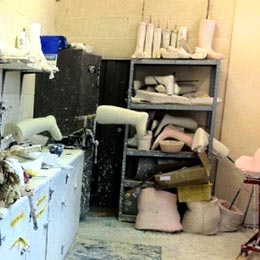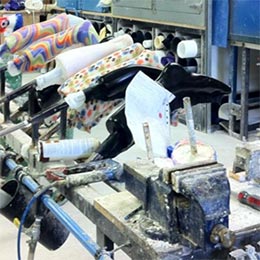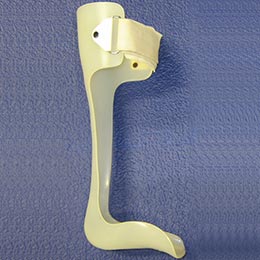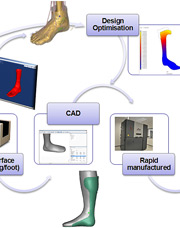- Home
- About A-FOOTPRINT
- Expected Results
- Case Study
Case Study
State of the Art: A Case Study
John had a cerebrovascular accident (stroke) in 2009 which left him with a left-sided hemiparesis. His left leg is weak and his foot drags as he is unable to lift the foot to give him ground clearance when he walks. This restricts his ability to undertake simple day-to-day activities which involve walking from place-to-place. He is restricted in participating in the hobbies and sports he once enjoyed and his quality of life has suffered.
A traditional, craftsmanship-based approach

Stage 1: AFO splints made using traditional hand fabrication techniques
John was provided with a custom-made ankle-foot-orthosis (AFO), a splint to support his weak leg whilst walking. This took several trips to the local hospital and over 4 weeks for the AFO to be fitted. The device wasn’t comfortable to start with and rubbed the bony parts around his ankle. The device was take away a three further times to be adjusted and refitted before it was comfortable to wear. The splint has improved John’s function but he still finds it heavy and unsightly to wear. Last year his first splint wore out and he had to go through the whole process for a new one to be fitted. The new device wasn’t comfortable and required further adjustments before he was able to replace his old AFO. John was left wondering why the new device wasn’t the same as the last one and why it didn’t fit and work as well.
Receiving a custom made ankle-foot orthosis

Stage 2: Skilled technicians shape the device using hand finishing tools
John’s AFO splint is made in an EU Orthotic SME company using traditional hand fabrication techniques. This involves an orthotist clinician attending the stroke clinic where John attends. The orthotist assesses John and prescribes a rigid polypropylene AFO. He records his findings and the prescription details to a standard company form.
He proceeds to take a Plaster-of-Paris impression of John’s leg, a messy and time-consuming process. The plaster cast is taken back to the factory from which a plaster cast is produced over the next few days.
From there a sheet of polypropylene is heated, draped over the plaster model and vacuum formed. The formed sheet is then removed from the cast and cut to shape. A skilled technician then proceeds to shape the device using abrasive wheels and hand finishing tools. The device is lined and retaining straps added to hold the splint in place. After quality control inspection the device is packaged and sent to the clinic for fitting.
The 5 week process

Stage 3: A polypropylene AFO splint
John returns to clinic for his polypropylene AFO splint to be fitted by the orthotist. After initial problems with fit and comfort John finally gets his device 5 weeks after his first visit to the clinic.
The clinical and AFO prescription record are retained on clinic forms. John’s plaster cast is bulky and stored for 2 months in the SME factory before being disposed.
When John requires a replacement the design and manufacture processes will have to start from the beginning of the value chain.
John’s story is a real-world case story of the traditional, craftsmanship-based approach to custom-made AFO splints. Now find out about the Beyond State of the Art process.
